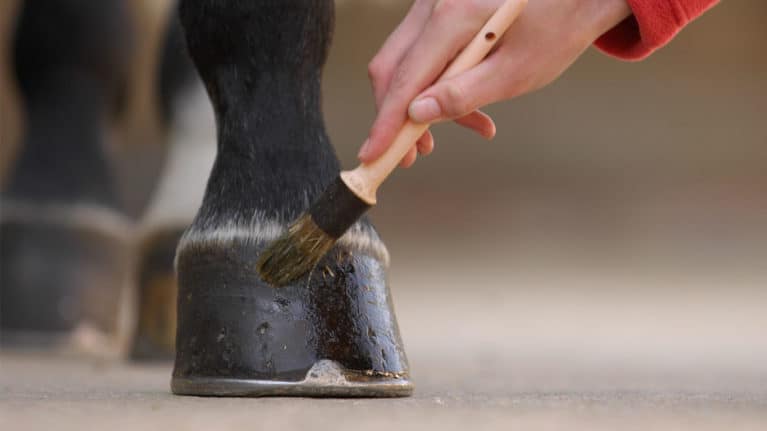As the temperatures rise and the ground gets harder, your horse’s hooves can change, too. H&R helps you keep them in great shape for all your summer plans with our hoof care tips

There’s nothing better than those first signs of summer – the sun on your back as you enjoy a post-work hack, the thrill of unearthing your competition kit as your show diary steadily fills up, the ice cream stash that starts to accumulate in the tack room freezer…
Like all good things, though, summer with horses doesn’t come without its fair share of work. Your horse’s needs change as the conditions change, and some of the first differences you’re likely to notice take place in his hooves. But lost shoes and cracks need not be a necessary evil in the warmer months – with some adjustments to your management regime, you can keep his hooves looking and feeling their best.
Summer schedules
Don’t think of your horse’s shoeing schedule as being fixed – you’ll reap the rewards if you work with your farrier to tailor it to his needs, the time of year and the amount of work he’s doing. You may find that your horse’s hooves need to be trimmed or shod more frequently in the summer, because they tend to grow faster as this time of year and increased workload may lead to shoes wearing faster, or he may need less frequent attention because his hooves are thriving on the firmer going. Maintaining a daily routine, keeping track of his hoof growth and communicating openly with your farrier are key to getting the balance right.
The biggest roadblock to healthy hoof function is inconsistent moisture levels – unfortunately, this is all too certain during the British summertime! Hooves that are consistently exposed to moisture – for example, during the muddier months – are able to compensate and cope with soft hooves, while horses in arid climates tend to have hard, strong hooves. However, when a hoof is repeatedly exposed to excessive moisture then dry conditions, followed by wet again, this is where problems begin.
When they’re exposed to water, your horse’s hooves will expand and soften as their moisture content increases. As the conditions become drier, his hooves will dry out and contract. This cyclical change in the hoof moisture can cause nails to loosen slightly and cracks to appear, increasing the risk of a pulled or twisted shoe.
There’s not much you can do to change the unpredictable weather, but you can control the amount of moisture that your horse’s hooves are exposed to by keeping the following things in mind…
- sponge your horse’s sweat patches after a ride rather than hosing him off. This will minimise the amount of time he spends standing in a puddle
- keep an eye on the ground around water troughs. Overfilling or slight leaks can lead to boggy ground in one of the parts of the field that your horse is most likely to visit
- ensure adequate drainage. If your horse is spending more time turned out in the warmer months, it’s important to make sure that he’s living in the best possible conditions. Check out our paddock MOT feature on page 110 for tip-top turnout
- turn out tactically. Turning your horse out overnight might be a great way to make your routine a bit easier, but bear in mind that dew can make moisture levels rise dramatically. If your horse’s hooves are struggling, consider stabling at night
- assess your horse’s bedding. If you decide to bring him in at night or if he tends to spend part of the day in his stable, your choice of bedding can have a significant impact on the amount of moisture that his hooves are exposed to. Consider a super-absorbent bed, such as watered wood pellets, which will contain the moisture and stop it from spreading through the bed
Daily down-low
Your daily hoof-care routine is so much more than just a quick pick-out before a ride. It’s an opportunity for you to closely inspect what’s going on with your horse’s feet, giving you the chance to learn what’s normal for him. Having this knowledge means that you’ll spot the slightest sign of trouble, such as a bit of bruising to the sole, and be able to deal with it before it becomes a bigger issue. Follow this five-step routine at least once a day and you’ll be well ahead of the game…
- Pick out your horse’s feet thoroughly, ensuring there’s no debris trapped underneath the shoe or alongside the frog.
- Using a stiff hoof brush, clean any stubborn dirt from his sole. This will allow you to spot any discolouration and you’ll also be able to identify any signs of infection in the frog.
- Check for uneven wear on the underside of his shoes, or on his hoof walls if he’s unshod.
- Inspect his hoof walls – are the nails starting to rise? Are there any new cracks or areas that feel warmer?
- Check your horse’s digital pulse on each leg. It’s not the speed of the pulse that you’re looking for, but the strength – if it feels strong and throbbing, particularly if it’s stronger in one leg, this is an indicator of localised pain and inflammation, and can suggest a problem such as a bruise or an abscess.
Your Comments
One thought on “Summer hoof care”
Leave a Reply
You must be logged in to post a comment.









This is an informative article which encouraged me to consider my horses hooves in more detail: having a thoroughbred with feet recovering from racing means I do anything I can to help. As well as a good supplement I use hoof oil daily on the walls and a moisturiser on his sole..is there any evidence that these work?